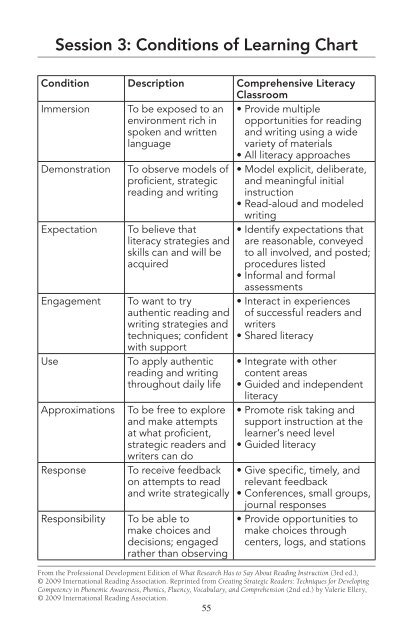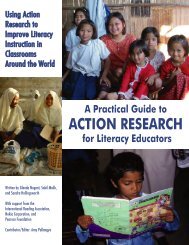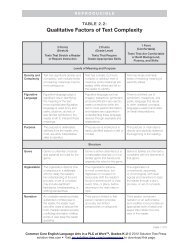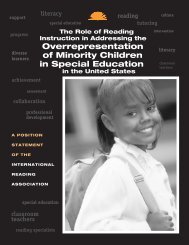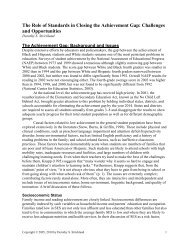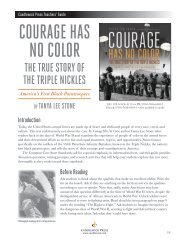What Research Has to Say About Reading Instruction - International ...
What Research Has to Say About Reading Instruction - International ...
What Research Has to Say About Reading Instruction - International ...
You also want an ePaper? Increase the reach of your titles
YUMPU automatically turns print PDFs into web optimized ePapers that Google loves.
Session 3: Conditions of Learning Chart<br />
Condition Description Comprehensive Literacy<br />
Classroom<br />
Immersion To be exposed <strong>to</strong> an<br />
environment rich in<br />
spoken and written<br />
language<br />
• Provide multiple<br />
opportunities for reading<br />
and writing using a wide<br />
variety of materials<br />
• All literacy approaches<br />
Demonstration<br />
Expectation<br />
Engagement<br />
Use<br />
Approximations<br />
Response<br />
Responsibility<br />
To observe models of<br />
proficient, strategic<br />
reading and writing<br />
To believe that<br />
literacy strategies and<br />
skills can and will be<br />
acquired<br />
To want <strong>to</strong> try<br />
authentic reading and<br />
writing strategies and<br />
techniques; confident<br />
with support<br />
To apply authentic<br />
reading and writing<br />
throughout daily life<br />
To be free <strong>to</strong> explore<br />
and make attempts<br />
at what proficient,<br />
strategic readers and<br />
writers can do<br />
To receive feedback<br />
on attempts <strong>to</strong> read<br />
and write strategically<br />
To be able <strong>to</strong><br />
make choices and<br />
decisions; engaged<br />
rather than observing<br />
• Model explicit, deliberate,<br />
and meaningful initial<br />
instruction<br />
• Read-aloud and modeled<br />
writing<br />
• Identify expectations that<br />
are reasonable, conveyed<br />
<strong>to</strong> all involved, and posted;<br />
procedures listed<br />
• Informal and formal<br />
assessments<br />
• Interact in experiences<br />
of successful readers and<br />
writers<br />
• Shared literacy<br />
• Integrate with other<br />
content areas<br />
• Guided and independent<br />
literacy<br />
• Promote risk taking and<br />
support instruction at the<br />
learner’s need level<br />
• Guided literacy<br />
• Give specific, timely, and<br />
relevant feedback<br />
• Conferences, small groups,<br />
journal responses<br />
• Provide opportunities <strong>to</strong><br />
make choices through<br />
centers, logs, and stations<br />
From the Professional Development Edition of <strong>What</strong> <strong>Research</strong> <strong>Has</strong> <strong>to</strong> <strong>Say</strong> <strong>About</strong> <strong>Reading</strong> <strong>Instruction</strong> (3rd ed.),<br />
© 2009 <strong>International</strong> <strong>Reading</strong> Association. Reprinted from Creating Strategic Readers: Techniques for Developing<br />
Competency in Phonemic Awareness, Phonics, Fluency, Vocabulary, and Comprehension (2nd ed.) by Valerie Ellery,<br />
© 2009 <strong>International</strong> <strong>Reading</strong> Association.<br />
55


